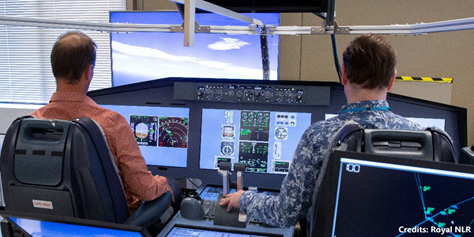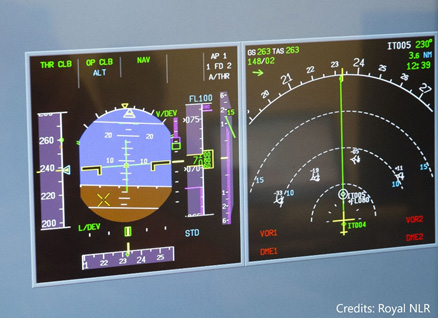Air traffic conflicts can be prevented by applying altitude constraints to deconflict aircraft ahead of time so that when they reach a crossing point they are vertically separated. This reduces the number of tactical interventions by air traffic control and enables uninterrupted and more efficient climb and descent profiles. In order to make these new procedures possible, pilots need to be well aware of the constraints and monitor their climb and descent performance so these altitude constraints can be met.
The Integrated TMA, Airport and Runway Operations (ITARO - PJ.37) project is demonstrating several solutions in the airport environment that improve efficiency both operationally as well as environmentally.
As part of the ITARO project, NLR conducted a pilot-in-the-loop evaluation to determine what kind of additional information on the cockpit displays can help improve the situational awareness with respect to altitude constraints. This evaluation is a demonstration of advanced climb and descent operations where departure and arrival routes are deconflicted with the use of altitude constraints at route crossings.
The pilot-in-the-loop evaluation was conducted in NLR’s APERO cockpit simulator. APERO is a fixed-base flight simulator that can be configured to simulate a wide range of aircraft types. Its flexible software enables easy and quick implementation of new cockpit systems and applications.
The newly developed climb performance monitor indications assist the pilot with timely identification and notification of not meeting the altitude constraint. Air traffic control should then be informed by the pilot as soon as possible to avoid a potential traffic conflict.
NLR implemented four different experimental indications on the primary flight display that provide the pilot with information on the current climb performance with respect to the next altitude constraint. During the experiment the pilots were asked to evaluate the different experimental indications and determine which indication provides the most situational awareness of the altitude constraints and the current climb performance.
The general conclusion from the piloted evaluation is that additional information on the climb performance with respect to the next altitude constraint does increase the situational awareness. This helps the pilot to timely identify that an altitude constraint might not be met. Each type of indication provides specific benefits and the pilots did not concur on what the most useful indication is. However, they did agree that a dedicated indication for the required climb performance monitoring purpose on the primary flight displays is very useful.
All feedback from the pilots will be used to derive a new type of indication that combines the best features of all four indications evaluated in this experiment. More results will be published on the ITARO project page: https://www.sesarju.eu/projects/itaro.

ITARO evaluation in APERO cockpit simulator at NLR

Experimental indications on the primary flight display provide information on the climb performance with respect to the next altitude constraint indicated with magenta bars on the V/DEV scale, the altitude tape, and the vertical speed scale.
This project has received funding from the SESAR 3 Joint Undertaking (JU) under grant agreement No 101017622. The JU receives support from the European Union’s Horizon 2020 research and innovation programme and the SESAR 3 JU members other than the Union.
